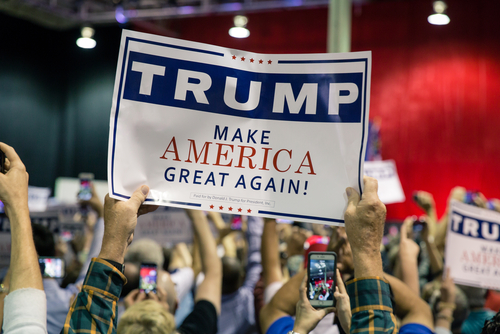
Bernie Sanders and Donald Trump have emerged as this election season’s two most unlikely stories. As Sanders has gained ground in the polls, Trump has held his. Neither candidate boasts the support of his party’s power brokers. For that matter, neither candidate has been a member of his party for long. Sanders joined the Democratic Party only in November; Trump’s partisan affiliation—much like his politics—has been all over the map.
Due in part to these trivial similarities, a media narrative emerged leading up to and, especially, after the two men won the New Hampshire primaries. According to some accounts, their enthusiastic and even angry bases of support mirror one another. (As NPR’s Tamara Keith stated during her New Hampshire primary coverage, both Sanders and Trump supporters “want to break stuff.”) According to another popular account, their anti-party and anti-establishment views render them bedfellows—if strange ones—in the struggle to wrest political power from those who currently wield it. Even Stephen Colbert, in a post-New Hampshire episode in which Sanders appeared as a guest on his Late Show, suggested that when comparing Sanders and Trump, “the difference is not yuge.”
Supporters of either candidate may swiftly dismiss or ignore these comparisons out of hand. We know that all political anger is not created equal. We know that on substance, on political experience, on policy acumen, and on, well, everything, Bernie Sanders and Donald Trump are not alike. And we find it hard to imagine that potential voters might take such sloppy—and perhaps even bizarre—comparisons to heart.
As campaign season nears Super Tuesday, however, the narrative of a Sanders-Trump ideological marriage is likely to grow. And it may become a marriage that Bernie supporters, in particular, need to annul quickly and forcefully. After all, not all potential voters are familiar with Sanders’ flavor of democratic socialism; media remarks superficially linking him to Trump may inflict damage, little-by-little, voter-by-voter.
Sure, some nationally recognizable commentators have already argued that these comparisons are nothing more than “stupidity from Punditville.” Stats geek Nate Silver implored readers in September to stop comparing the two because, among other reasons, Sanders has spent his career in politics; Sanders holds coherent (and coherently Democratic) policy positions; and Trump is winning whereas Sanders—at least at that point—was not.
Still left unaddressed, however, is the most popular—and perhaps the most intellectually convincing—similarity between the two insurgent contenders. That is, Sanders and Trump share a common label: “populist.”
Populisms, Thick and Thin
If we want to understand the growing fixation upon Sanders, Trump, and the alleged common ground upon which they walk, we need to pin down the characteristics that provide content for the “populist” label. Common across most definitions of the term is the idea that ordinary people ought to reclaim power over the democratic process—power currently held by elites and special interests. While this governing ethos has roots in the agrarian movement of the American West, the distinction between a virtuous citizenry and a corrupting class of powerful elites serves as populism’s defining feature. By it’s very nature, it rests on an antagonistic—and yes, even angry—claim about the nature of modern democratic politics.
Certainly, no political party lays exclusive claim to this rhetoric (though a political party did carry its name). For this reason, populism does not fit neatly within the conventional left-right (or liberal-conservative) divide, as it exists more as a way of mobilizing citizens than it does as a coherent set of policy positions or platforms. Put simply, populists exist all over the political map.
Despite extraordinary differences, then, left populists (like Sanders) and right populists (like Trump) are forced to share a common ideological signifier. Different though many of us know these candidates to be, the populist label suits Sanders and Trump better than any two other candidates in the field of presidential contenders. Importantly, though, their populisms are not alike, nor are they even similar. Put most simply, the two men hold starkly different views about who qualifies as “elite,” what forms of civic participation are healthy for democracies, and, relatedly, how citizens might empower themselves once they overcome elite rule.
In his book Punishment, Participatory Democracy, and the Jury, political theorist Albert Dzur distinguished between two different populisms: thick populism and thin populism. These distinctions should help to dispel any notion that Sanders and Trump promote or engender a common political agenda.
To supporters of a thick populism, bureaucratic institutions are at risk of succumbing to technocracy or other forms of expert or professional rule. Importantly, though, bureaucrats, “experts,” and the public institutions with which they work are not themselves the problem. In fact, these officials may merit respect and even deference so long as they maintain a connection with ordinary citizens. Thus, these figures are not all self-serving elites, per se. Rather, their work becomes compromised when it suffers from too little democracy, that is, when “the people” lose their control over the institutions that act on its behalf. So long as they engage citizens and the civic organizations that enhance citizens’ capacity for self-governance—unions, professional associations, nonprofit community groups, and so on—public agencies can, indeed, serve the populist agenda.
As a “thick” populist, Sanders does not castigate the government—or at least every possible government—as a group of out-of-touch elites. Rather, he credits FDR’s New Deal government, for example, for “redefin[ing] the relationship of the federal government to the people of our country,” as he proclaimed in a November 2015 speech on democratic socialism. In this respect, big government is acceptable and at times preferred if (and only if) it is robustly inclusive and authorized by the grassroots.

Who are the elites to be feared, then? To anyone remotely familiar with the Sanders campaign, the answer is obvious: the wealthy, profit-driven interests (“the billionaire class”) that coopt the democratic process with large campaign contributions and highly-paid teams of lobbyists, and subvert government agencies such that they become tools of wealthy interests. Government turns into an elite class to be feared precisely when it begins to serve these economic elites at the expense of the rest of us. At this point, according to Sanders and other democratic socialists, democracies do not live up to their name.
“Thin” populism, by contrast, is thin precisely because it carries a thin conception of democracy itself. Thin populists are not interested in “thickening” the democratic spirit or creating more participatory civic institutions. Rather, thin populists view bureaucrats, public agencies, and so-called experts with an inherent distrust. Such groups intrude upon ordinary citizens’ lives and serve their own power-hungry ends. Whereas “thick” populists’ trust unions and other nonprofits that are not governed by wealthy interests, thin populists like Trump do not view the problems of government as problems of too little democracy. Rather, they view the problems of government to be that government governs at all.
This is not to suggest, of course, that Trump would like to do nothing with government at all. Rather, Trump’s populism is akin to what criminologist John Pratt has called “penal populism,” or the idea that fear and insecurity motivate citizens to become politically active in a matter that rejects or antagonizes public officials, elites, and other policymakers. From this perspective, then, civic participation becomes an exercise of passion, prejudice, and punishment, and populist leadership becomes an exercise of demagoguery and jingoism. Expertise, deliberation, and responsible governance be damned. The end of government is to punish the punishable.
In short, Sanders’ populism approaches government agencies as necessary actors and potential allies in the fight against those aiming to distort the democratic process to serve their own capitalist ends. This class, of course, includes Trump himself. Trump’s populism, by contrast, views bureaucrats, government agencies, and elected officials as threats to the integrity and security of ordinary citizens.
It should be noted, here, that Trump’s rhetoric about governmental incompetence is about as pervasive as his headline-grabbing remarks about religious or ethnic groups. In the end, both his antipathy toward bureaucrats and his aversion to a heterogeneous society serve as twin pillars of a dangerous form of populism that bears no resemblance to Sanders’s political objectives.
The Trumpification of Sanders: Who Wins and Who Loses?
In the context of electoral politics, the counterpoint to populism—if an equally problematic buzzword—is “the establishment.” If Sanders and Trump represent the insurgent populists of the Democratic and Republican parties, respectively, Hillary Clinton, Marco Rubio, Jeb Bush, and John Kasich represent the party establishments, albeit to varying degrees. Yet few media figures have tried to convince their audiences that, say, Hillary Clinton and Marco Rubio share core political ideologies. A Clinton presidency would look quite different than a Rubio presidency, even if lukewarm comparisons might suggest that they both serve their parties’ entrenched interests.
Importantly, these establishment figures stand to benefit most from these Sanders-Trump comparisons. Democratic voters do not want to vote for a candidate with a strong family resemblance to a bogeyman like Trump. (Likewise for potential Republican voters, who may not want to vote for anyone whose name is uttered in the same breath as a democratic socialist.) Establishment candidates and the media who cheerlead them know what they are doing when they compare Sanders and Trump. When prominent media outlets cast the two as “two populist peas in a pod,” as did the conservative National Review, such outlets are proactively trying to boost the establishment candidacies. When Bill Clinton compares Bernie Sanders to the Tea Party movement, we know that campaign season has clouded reasonable and responsible political analysis.
While a genuine curiosity about the unexpected successes of Sanders and Trump may have fueled these overblown comparisons as they emerged last fall, savvy establishment candidates will likely exploit these alleged likenesses as primary season unfolds. In the case of conservative media, they know that they can’t win with Trump in a head-to-head battle with either Sanders or Clinton (though the early polling seems to suggest that Trump might fare better against Clinton than against Sanders.) We know why Bill O’Reilly wants to compare Sanders to Trump: He doesn’t want Trump to poison the GOP more than he already has. For mainstream-to-leftish organizations and media figures like NPR, MSNBC, or Stephen Colbert, however, the comparisons are simply irresponsible.
Put mildly, it’s time to stop the insanity. Bernie Sanders is not Donald Trump. Donald Trump is not Bernie Sanders. Not all populisms are created equal. One opposes “elite” conceptions of American democracy by revitalizing our conception of the public sphere, calling for an end to Big Money’s contamination of the political process, and energizing young voters who wish to be stakeholders in their own future. The other…is Donald Trump. It’s time to build a wall between the two candidacies. The differences couldn’t be more yuge.